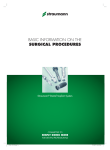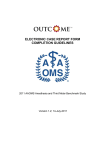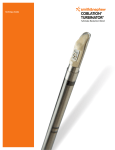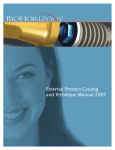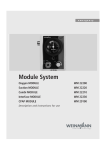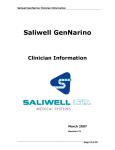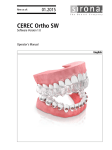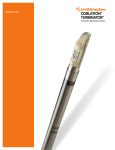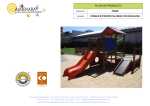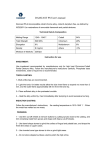Download User Manual MIS Crest Widener
Transcript
User Manual MIS Crest Widener Designed by Dr. Zvi Laster ® Introduction The MIS Crest Widener is used to widen a narrow alveolar crest which has sufficient height so as to prepare the ridge for implantation. With this technique, bone augmentation is avoided, the implant is placed in the correct lateral position and sufficient attached gingiva is obtained. The Crest Widener consists of 4 arms, 2 on each side, connected with guiding pins and an activating screw. The Crest Widener is inserted after cutting 3 mucoperiosteal incisions (without stripping the bone) as well as cutting and splitting the narrow alveolar crest. By rotating the activating screw, each pair of arms moves away from the other 2 arms, thus pushing the buccal cortical bone apart. Activation starts 5 - 7 days (latency period) after the insertion of the device. By separating the cortical plates, new bone is created in between (Distraction Osteogenesis), and the attached gingiva is simultaneously distracted. The procedure is conducted under local anesthesia in one or two stages. Indications for MIS Crest Widener Preparing the narrow alveolar crest for implantation as an alternative to bone augmentation. Contra-indications In cases where the alveolar ridge has insufficient vertical height (less than 10mm), or where there is an absence of cancellous bone between the two crestal cortical bones. Advantages 1.The transported bone is not stripped from periosteum, therefore, no post-operative bone resorption. 2.Simple, short, minimally invasive procedure. 3.No morbidity or painful donor site. 4.Less technique-sensitive. Advantages (continuation) 5. Implant placement is possible after extremely short post-operative period (4-8 weeks). 6. The procedure is easily performed in a dental office, under local anesthesia. 7. Minimally compromised aesthetics. 8. Enables ideal lateral implant positioning when needed. Intraoperative approach The MIS Crest Widener is inserted in one or two stages with local anesthesia via submucosal infiltration. * Crest widening can be performed in all maxillary and mandibular areas. Step-by-step procedure The one-stage procedure 1. 2. Three incisions are made along the desired area under local anesthesia: 2 vertical, anteriorly and posteriorly, and 1 crestal incision (Fig. 1). These incisions are made through the mucosa and the periosteum. The top of the crest is exposed lingually/palataly, leaving the buccal side unstripped (Fig. 2) and a trough is drilled along the lingual/palatal aspect using a 1mm round burr (Fig. 3). Fig. 1 Fig. 2 Fig. 3 3. 4. A sagittal cut of crestal bone is made followed by anterior and posterior cuts through the mucoperiosteal incisions (Fig. 4/Fig. 5). No bone stripping! A vestibular bone cut (Fig. 6) is made with a round small bur after tunneling at the vestibular end of the anterior vertical incision. No bone stripping! If the crest is narrow, but has a triangular shape with a wide base, it is possible to fracture the buccal plate without a vestibular bone cut. Either a Scalpel reciprocating saw, a thin long tungsten fissure bur or a Piezo machine can be used. Fig. 4 Fig. 5 Fig. 6 5. 6. The buccal bone is fractured using a thin osteotome (Fig. 7). It is important to verify the fracture by manipulating the osteotome. Placement of the Crest Widener: For security reasons, a titanium wire is threaded through the hole in the arm prior to the insertion of the device (Fig. 8a). The Crest Widener is gently tapped half-way into the bony cut with the index finger (Fig. 8b). The crestal Fig. 7 Fig. 8a Fig. 8b 6. (continuation) 7. and the vertical incisions are then sutured. After final tapping of the device, the Crest Widener is secured (Fig. 8c) with the fine titanium ligature to an adjacent tooth, leaving 1mm above the crest for cleaning (Fig. 8d). Activating trial: In order to ensure stabilization of the widener two anti-clockwise turns are made (Fig. 9). This step will engage the small sharp spikes to the cortical bone and indicate whether the buccal plate is freely movable. Fig. 8c Fig. 8d Fig. 9 The two-stage procedure 1st stage 1. 2. Under local anesthesia, 3 incisions, which will define the area for expansion, are made along the ridge. 2 vertical incisions anteriorly (Fig. 10a) and posteriorly (Fig. 10b) and one horizontal incision at the vestibulum. 10mm below the crestal peak (Fig. 10c). These incisions are made through the mucosa and the periosteum. Anterior (Fig. 11 a) and posterior (Fig. 11 b) vertical bone cuts are made through the mucoperiosteal incisions without bone stripping. This is followed by a bone cut of the cortical bone at the vestibulum (Fig. 11c).To prevent jeopardizing the blood supply to the bone, periosteal stripping must always be from the bone cut downwards in the mandible and upwards in the maxilla! Either a Scalpel reciprocating saw, a thin long tungsten fissure bur or a Piezo machine, can be used for cutting the bone. Fig. 10 a.b.c Fig. 11 a.b.c 3. All incisions are sutured (Fig. 12). The two-stage procedure 1st stage (3 weeks later) Fig. 12 4. A crestal incision is made along the desired area under local anesthesia. The crest is minimally exposed (Fig. 13a) and by using a small (1mm) round burr (Fig. 13b) a trough is made along the crest on the lingual/palatal aspect. A bone cut is then made through the prepared trough to a depth of at least 10mm by using a reciprocating scalpel saw or tungsten burr (Fig. 13c). Fig. 13a Fig. 13b Fig. 13c 5. 6. The buccal bone is fractured using a thin osteotome (Fig. 14). It is important to verify the fracture by manipulating the osteotome. Placement of the Crest Widener: For security reasons a titanium wire is threaded through the hole in the arm, prior to the insertion of the device (Fig. 15a). The Crest Widener is gently tapped half-way into the bony cut with the index finger (Fig. 15b). The crestal incision is then sutured. Fig. 14 Fig. 15a Fig. 15b 6. (continuation) 7. After final tapping of the device, the Crest Widener is secured (Fig. 15c) with the fine titanium ligature to an adjacent tooth, leaving 1mm above the crest for cleaning (Fig. 15d). Activating trial: In order to ensure stabilization of the widener, two anticlockwise turns are made (Fig. 16). This step will engage the small sharp spikes to the cortical bone and indicate whether the buccal plate is freely movable. Fig. 15c Fig. 15d Fig. 16 Activation of the MIS Crest Widener 1.The activation is achieved by anti-clockwise rotation of the key by patient or family member. The recommended rate is 1/4 of a turn twice a day (0.45 mm each full turn), for 4 days of activation and one day of rest, unless other instructions were given by your dentist. The patient should be examined by the surgeon every 5-6 days. 2.It is recommended to perform slight over-distraction of 1mm to compensate future relapse. 3.Once the sufficient width is obtained (after 15-25 days), activation is ceased. The Crest Widener is left for 1-2 weeks to consolidate the distracted area. 4.If the device loosens during the consolidation period, it must be removed under local anesthesia and the implant should be placed in the area during the same session or 5-7 days later. 5.The minimum opening space to insert the crest widener is 2mm. 6.The maximum operational activation limit is 6mm. 7.Maximum working load required = 20Ncm. The Crest Widener can support a maximum load of 60Ncm. Removal of the MIS Crest Widener The activating screw should be turned clockwise three full turns to disengage the retentive spikes, then it can be withdrawn (under local anesthesia). No soft tissue closure is necessary after the removal of the device. Implantation Implantation can be performed on the same day that the Crest Widener is removed, and up to 5-7 days later. The transmucosal approach is the recommended technique to minimize soft tissue exposure and avoid undue bone resorption. Since the callus is still soft only 1mm depth of mucosal lining is removed, by using a tungsten fissure burr, which is then followed by drilling through the opening for implantation. The implant should be immersed into the callus 1-2mm and the healing cap put in place. Recommendations for the surgeon - Avoid unnecessary stripping of the periosteum in order to reduce bone resorption. - Attempt to perform the crestal bony cut on the lingual/palatal cortical bone, since these are thicker and more compact than the buccal bone. - Either the scalpel reciprocating saw, the thin long tungsten fissure burr or the Piezo machine can be used for the bony cuts. - The Piezo machine is the recommended technique for this procedure under local anesthesia, since it is the most comfortable for the patient. - Impaired dental aesthetics in the anterior segments can be avoided by an Omnivac Vacuum Egg Shell with denture teeth as a provisional bridge. Recommendations for the surgeon (continuation) - After tapping the Crest Widener, always ensure that the bone fragment is loosened by activating the distractor 2 full anti-clockwise turns and 1 clockwise turn. The stability of the device is increased when it is activated. - If the bone fragment is not loosened, use a thin osteotome to free it. - Always secure the distractor to an adjacent tooth with the titanium wire of 1/0 black silk or a nylon suture. - If the distractor is loosened after the activation is stopped, remove the distractor and insert the implants. - Antibiotic cover is recommended. Patient instructions: - Cold soft food and drinks for 24 hours. Avoid chewing on the distracted side. Antiseptic mouth rinse and gentle brushing of distractor and widened region. Self-activation of the device 1/4 of a turn twice a day, unless other instructions were given by your dentist. One day rest after every 4 days of activation. Make sure to be examined by your surgeon at least every 5-6 days. Patient instructions: Patient instructions (continuation) - If the device is loosened after the activation is stopped, see your surgeon as soon as possible. - Slight pressure might be felt at the beginning of the activation and towards completion. Sterilization - The device is not sterile. - The device must be sterilized before use by autoclave, at a temperature of 134°C (273°F) for 6 minutes. - Do not exceed 134°C during sterilization. - The device is for single use, for only one patient, do not reuse. Manufacturer By prescription only Lot number Catalog number Single use, do not reuse, use only once Attention, see Instructions For Use Do Not Use if Package is Damaged © MIS Corporation. All Rights Reserved Non-Sterile MP-UI017 Rev. 9 Manufactured by: MIS Implants Technologies Ltd. P.O. Box 7 Bar Lev Industrial Park, 2015600, Website: www.mis-implants.com MIS Implants Technologies GmbH Simeonscarre 2, 32423 Minden, Germany Tel: +49 571-972-7620 Email: [email protected] MIS Corporation. All Rights Reserved.




















